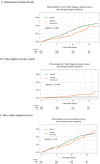Association Between Benign Breast Disease in African American and White American Women and Subsequent Triple-Negative Breast Cancer
- PMID: 28006062
- PMCID: PMC5796807
- DOI: 10.1001/jamaoncol.2016.5598
Association Between Benign Breast Disease in African American and White American Women and Subsequent Triple-Negative Breast Cancer
Abstract
Importance: Compared with white American (WA) women, African American (AA) women have a 2-fold higher incidence of breast cancers that are negative for estrogen receptor, progesterone receptor, and ERBB2 (triple-negative breast cancer [TNBC]). Triple-negative breast cancer, compared with non-TNBC, likely arises from different pathogenetic pathways, and benign breast disease (BBD) predicts future non-TNBC.
Objective: To determine whether AA identity remains associated with TNBC for women with a prior diagnosis of BBD.
Design, setting, and participants: This study is a retrospective analysis of data of a cohort of 2588 AA and 3566 WA women aged between 40 and 70 years with a biopsy-proven BBD diagnosis. The data-obtained from the Pathology Information System of Henry Ford Health System (HFHS), an integrated multihospital and multispecialty health care system headquartered in Detroit, Michigan-include specimens of biopsies performed between January 1, 1994, and December 31, 2005. Data analysis was performed from November 1, 2015, to June 15, 2016.
Main outcomes and measures: Subsequent breast cancer was stratified on the basis of combinations of hormone receptor and ERBB2 expression.
Results: Case management, follow-up, and outcomes received or obtained by our cohort of 2588 AA and 3566 WA patients were similar, demonstrating that HFHS delivered care equitably. Subsequent breast cancers developed in 103 (4.1%) of AA patients (mean follow-up interval of 6.8 years) and 143 (4.0%) of WA patients (mean follow-up interval of 6.1 years). More than three-quarters of subsequent breast cancers in each subset were ductal carcinoma in situ or stage I. The 10-year probability estimate for developing TNBC was 0.56% (95% CI, 0.32%-1.0%) for AA patients and 0.25% (95% CI, 0.12%-0.53%) for WA patients. Among the 66 AA patients who developed subsequent invasive breast cancer, 16 (24.2%) developed TNBC compared with 7 (7.4%) of the 94 WA patients who developed subsequent invasive breast cancers and had complete biomarker data (P = .01).
Conclusions and relevance: This study is the largest analysis to date of TNBC in the context of racial/ethnic identity and BBD as risk factors. The study found that AA identity persisted as a significant risk factor for TNBC. This finding suggests that AA identity is associated with inherent susceptibility for TNBC pathogenetic pathways.
Figures

Similar articles
-
Comparative Analysis of Breast Cancer Phenotypes in African American, White American, and West Versus East African patients: Correlation Between African Ancestry and Triple-Negative Breast Cancer.Ann Surg Oncol. 2016 Nov;23(12):3843-3849. doi: 10.1245/s10434-016-5420-z. Epub 2016 Jul 28. Ann Surg Oncol. 2016. PMID: 27469125
-
Outcome of African-American compared to White-American patients with early-stage breast cancer, stratified by phenotype.Breast J. 2021 Jul;27(7):573-580. doi: 10.1111/tbj.14225. Epub 2021 Mar 18. Breast J. 2021. PMID: 33738890
-
Clinical characteristics of breast cancers in African-American women with benign breast disease: a comparison to the surveillance, epidemiology, and end results program.Breast J. 2014 Nov-Dec;20(6):571-7. doi: 10.1111/tbj.12331. Epub 2014 Sep 8. Breast J. 2014. PMID: 25200244 Free PMC article.
-
Racial Disparities in Triple Negative Breast Cancer: A Review of the Role of Biologic and Non-biologic Factors.Front Public Health. 2020 Dec 22;8:576964. doi: 10.3389/fpubh.2020.576964. eCollection 2020. Front Public Health. 2020. PMID: 33415093 Free PMC article. Review.
-
Health Disparities and Triple-Negative Breast Cancer in African American Women: A Review.JAMA Surg. 2017 May 1;152(5):485-493. doi: 10.1001/jamasurg.2017.0005. JAMA Surg. 2017. PMID: 28355428 Review.
Cited by
-
Patient-Derived Xenografts as an Innovative Surrogate Tumor Model for the Investigation of Health Disparities in Triple Negative Breast Cancer.Womens Health Rep (New Rochelle). 2020 Sep 24;1(1):383-392. doi: 10.1089/whr.2020.0037. eCollection 2020. Womens Health Rep (New Rochelle). 2020. PMID: 33786503 Free PMC article. Review.
-
Feasibility of risk assessment for breast cancer molecular subtypes.Breast Cancer Res Treat. 2024 Nov;208(1):103-110. doi: 10.1007/s10549-024-07404-9. Epub 2024 Jun 25. Breast Cancer Res Treat. 2024. PMID: 38916820 Free PMC article.
-
Vitamin D receptor polymorphisms and associated miRNAs in the development of breast cancer in African American women.Gene. 2024 Nov 15;927:148695. doi: 10.1016/j.gene.2024.148695. Epub 2024 Jun 28. Gene. 2024. PMID: 38945313
-
Sistas Taking a Stand for Breast Cancer Research (STAR) Study: A Community-Based Participatory Genetic Research Study to Enhance Participation and Breast Cancer Equity among African American Women in Memphis, TN.Int J Environ Res Public Health. 2018 Dec 18;15(12):2899. doi: 10.3390/ijerph15122899. Int J Environ Res Public Health. 2018. PMID: 30567326 Free PMC article.
-
Differences in somatic TP53 mutation type in breast tumors by race and receptor status.Breast Cancer Res Treat. 2022 Apr;192(3):639-648. doi: 10.1007/s10549-022-06509-3. Epub 2022 Mar 14. Breast Cancer Res Treat. 2022. PMID: 35286522 Free PMC article.
References
-
- Carey L, Winer E, Viale G, Cameron D, Gianni L. Triple-negative breast cancer: disease entity or title of convenience? Nat Rev Clin Oncol Dec. 2010;7(12):683–692. - PubMed
-
- Newman LA, Reis-Filho JS, Morrow M, Carey LA, King TA. The 2014 Society of Surgical Oncology Susan G. Komen for the Cure Symposium: triple-negative breast cancer. Ann Surg Oncol. 2015 Mar;22(3):874–882. - PubMed
MeSH terms
Grants and funding
LinkOut - more resources
Full Text Sources
Other Literature Sources
Medical
Research Materials
Miscellaneous

